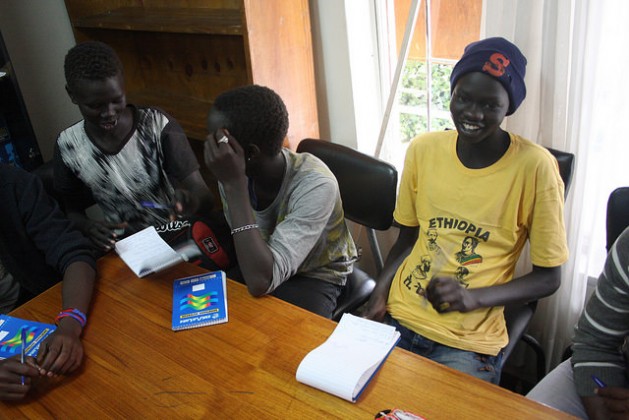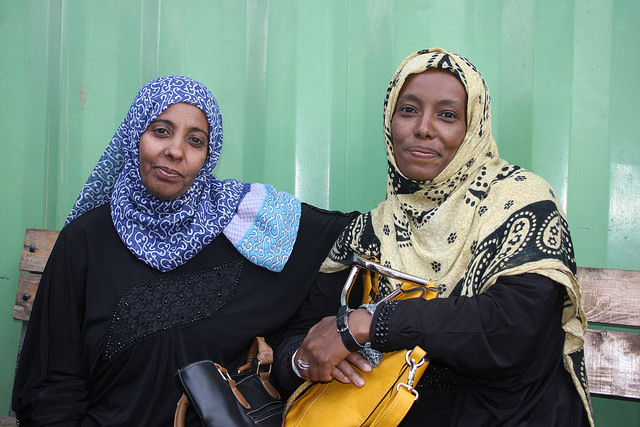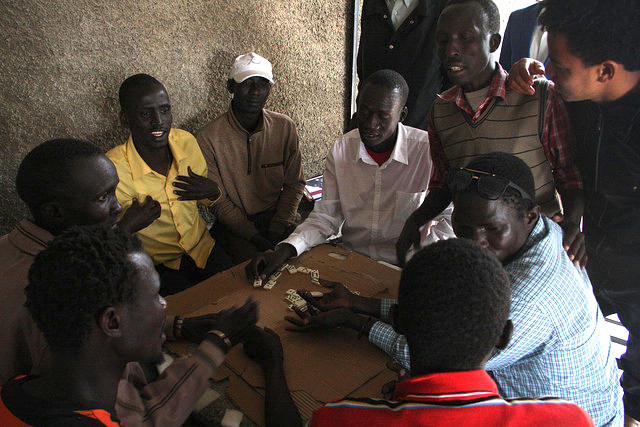Date: Wed, 2 Nov 2016 00:29:19 +0100
Int’l Effort to Help Ethiopia Shoulder Its Refugee Burden

Young South Sudanese refugees studying in the library of the Jesuit Refugee Service in Addis Ababa. Credit: James Jeffrey/IPS
- A concerned-looking group of refugees gather around a young woman grimacing and holding her stomach, squatting with her back against a tree. But this is no refugee camp, rather the Jesuit Refugee Service (JRS) compound just off a busy main road leading to Sidist Kilo roundabout in the Ethiopian capital.
After a couple of minutes, the pain has subsided enough to let her talk. She says has been experiencing abdominal pains for a few weeks, though in answer to one particular question she manages a smile before replying she doesn’t think it’s a pregnancy. She says she arrived from Eritrea about seven months ago in an attempt to join her husband in Italy.
Ever since Ethiopia’s late long-term ruler Meles Zenawi established an open-door policy toward refugees, the country’s refugee population has swelled to more than 700,000, the largest in Africa. And due to ongoing crises in neighbouring countries such as South Sudan, Eritrea and Somalia, that number isn’t shrinking. In the first week of October about 31,000 people streamed over the border from South Sudan into Ethiopia’s western region.
Providing refuge, however, doesn’t extend to also providing employment rights. Ethiopia has plenty on its hands trying to satisfy its indigenous mushrooming young population that needs jobs. Hence the joint initiative by the UK, the European Union and the World Bank to address both dilemmas through the building of two industrial parks to generate about 100,000 jobs, at a cost of 500 million dollars, with Ethiopia required to grant employment rights to 30,000 refugees as part of the deal.
But after the announcement comes the thornier issue: putting it all into action.
“All the stakeholders of this project need to get their heads together and come up with a workable formula that would benefit both Ethiopians and the refugees,” says Kisut Gebreegziabher with the Ethiopia office for the United Nations High Commissioner for Refugees (UNHCR). “There needs to be a clear policy of engaging the refugees in this project, including clarity about the level of their engagement.”
The initiative is part of a pilot programme also supporting Niger, Nigeria, Senegal and Mali, and according to those involved, reflective of a new strategy for tackling the migrant crisis afflicting both Europe and Africa, based on a shift in developmental aid toward focusing on economic transformation in developing countries.
“We’re putting migrant-related issues at the heart of our support to countries,” Francisco Carreras, Head of Cooperation at the Delegation of the European Union to Ethiopia, says of the 250 million dollars coming from the EU. “Our investment is not going to solve the problem but it may have a domino effect by showing others that this can work.”
Hopeless days
“I’ve been idle for three years and my plan is to remain idle, that’s all I can do,” says 28-year-old Daniel, a qualified dentist who fled Eritrea for Ethiopia after his involvement with a locally produced publication drew the government’s wrath. Based on his qualifications he managed to find a potential healthcare job in Addis Ababa. “The employer said I was a good match but when he checked with the authorities they said I couldn’t be employed.”
Although Ethiopia’s authorities often turn a blind eye to refugees doing casual work, Ethiopia’s proclamation on refugees prohibits them from official employment.
“If Ethiopia feels for refugees, why doesn’t it change the law so they can work?” says Shikatende, a 35-year-old Congolese refugee who has been in Ethiopia for seven years. “It’s a free prison here. We are free to stay but with no hope or future.”
A change in the law will be required for the industrial park initiative, observers say, although any wholesale opening of Ethiopia’s job market to refugees is highly unlikely while Ethiopia’s 100 million population continues growing by 2.6 percent a year.
“That means creating millions of new jobs every year, the challenge for Ethiopia is huge,” Carreras says, adding that the giving of millions of euros to Ethiopia is far from altruism. “It’s in our own interests and a matter of survival for us: we can’t be surrounded by countries in difficulties and expect that building a wall or the sea alone will keep us sanitized from others’ problems.”
In the Jesuit Refugee Service compound in Addis Ababa, South Sudanese play their dominoes with much passion. Credit: James Jeffrey/IPS
Now in its 20th year, the JRS compound resembles a microcosm of Africa’s—and the Middle East’s—troubles, hosting refugees from South Sudan, Congo, Uganda, Somalia, Eritrea, Yemen, Burundi and more. The organisation aims to assist 1,700 people in 2016, says Hanna Petros, the centre’s director, noting that Addis Ababa contains up to 20,000 refugees. “That’s registered ones—there are others who aren’t registered.”
Build it and they will come…or will they?
Despite his enthusiasm for the project, Carreras admits that success requires fending off myriad challenges.
“You’ve got to build the right sectors in the right places and ensure the right procurement—achieving all those ‘rights’ isn’t easy,” he says. And even if all that is pulled off, he adds, you’ve then got to attract the investors, after which you have to make sure it’s all sustainable: investors must obtain enough profit so they remain and don’t leave after a couple of years.
Those connected to the Ethiopian government appear confident that history is on Ethiopia’s side.
“Thirty years ago, large-scale labour left the U.S. and Europe and moved to China,” says Zemedeneh Negatu, an economic adviser to the Ethiopian government. “But monthly labour costs there now are around 450 to 600 dollars a month—Ethiopia is a fraction of that, added to which a lot of the raw materials are already coming from here.”
Hence Ethiopia’s embracing of industrial parks, which Prime Minister Hailemariam Desalegn has placed at the forefront of economic strategy.
In addition to the two parks being funded by the joint initiative, another seven are in the process of being built at a rough cost of 250 million dollars each. One industrial park is already operating around Awassa, about 300km south of Addis Ababa, where it’s serving as a promising bellwether having attracted more investor interest than it could accommodate, Carreras says.
But all of a sudden Ethiopia’s reputation as a safe investment option—attracting tens of billions of dollars in foreign investment over the past decade—is looking increasingly tenuous.
Protests against the government that have been smouldering since November 2015 have taken on a more violent edge recently. At the beginning of October, more than two dozen foreign companies suffered millions of dollars in damage.
The timing clearly doesn’t help when it comes to luring foreign investors into industrial parks. By the middle of October foreign embassies in the capital were holding situation briefings with concerned investors to try and allay mounting concerns. And at least those foreign investors have options.
“The situation makes me nervous,” Daniel says. “Not only am I a foreigner but I’m from an enemy country. It could get bad. They can beat me or kill me, there’s no one to protect me.”
Wrong sort of human capital
“It was a bold and brave decision by Ethiopia to offer to take in foreigners when so many of its own have dire needs,” Carreras says, contrasting this stance with how Hungary recently voted against housing about 18,000 refugees.
But at the same time, there is a less salubrious side to the refugee situation in Ethiopia. Encountering groups of refugees in Addis Ababa, it’s not long before someone is sidling up to you, eyes furtively glancing around, wanting to talk about problems.
Many have harsh words for both UNHCR and Ethiopia’s Administration for Refugee and Returnee Affairs (ARRA), while giving an impression of rank corruption in certain areas.
Refugees talk of thousands of dollars changing hands so Ethiopians can pose as refugees for resettlement in Europe, scholarship funding meant for refugees being given to Ethiopians, and the numbers of refugees in Ethiopia being inflated to ensure foreign funding keeps coming in.
“The numbers are accurate and based on research by UNHCR,” says Zeynu Jernal, ARRA’s deputy director. “We gain no financial benefits from the Ethiopian operation and are in fact underfunded—last year the required 280-million-dollar budget was only 60 percent funded.”
Zeynu acknowledges that giving 30,000 refugees jobs still leaves many more without—hence other schemes being initiated: 20,000 refugee households being given land so they can farm, thereby benefiting a total of about 100,000; 13,000 long-term Somali refugees being integrated into the eastern city of Jijiga with resident and work permits; and higher education opportunities for refugees who pass the university entrance exams.
In official quarters there is praise for the industrial park initiative, with talk of how it fits into a “new and all-encompassing approach towards alleviating the plight of refugees staying in Ethiopia” through better and more work opportunities, and through improved local integration and assimilation. Some of the refugees in Addis Ababa who have been following news about the initiative online, however, seem less sure whether refugees will really benefit.
“Refugees in Ethiopia is a business, that’s what needs to be addressed,” Shikatende says. “But it’s not just here, it’s happening all over Africa.”
He adds that another problem is the muddling of three types of refugees: economic refugees seeking better work opportunities, so-called supporter refugees trying to join relatives who have already settled abroad, and “real” refugees who meet the terms laid out by the United Nations’ 1951 Refugee Convention.
“If you want to solve the refugee problem you need to deal with the real cause of refugees which is African leaders—but you [foreign donors] are providing them with more money,’ Shikatende says.
When it comes to a timeline for completion of the two industrial parks, how refugees will be chosen for the earmarked jobs, the challenges that need to be overcome to make the project a success, both UNHCR and ARRA say it is too early to comment although meetings are ongoing to hash out the logistics.
“We are waiting for the plan,” says one refugee organisation worker.

